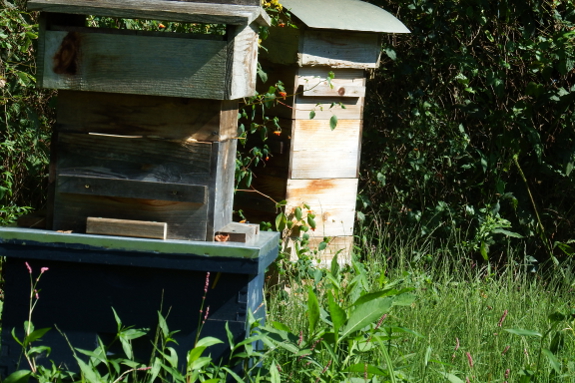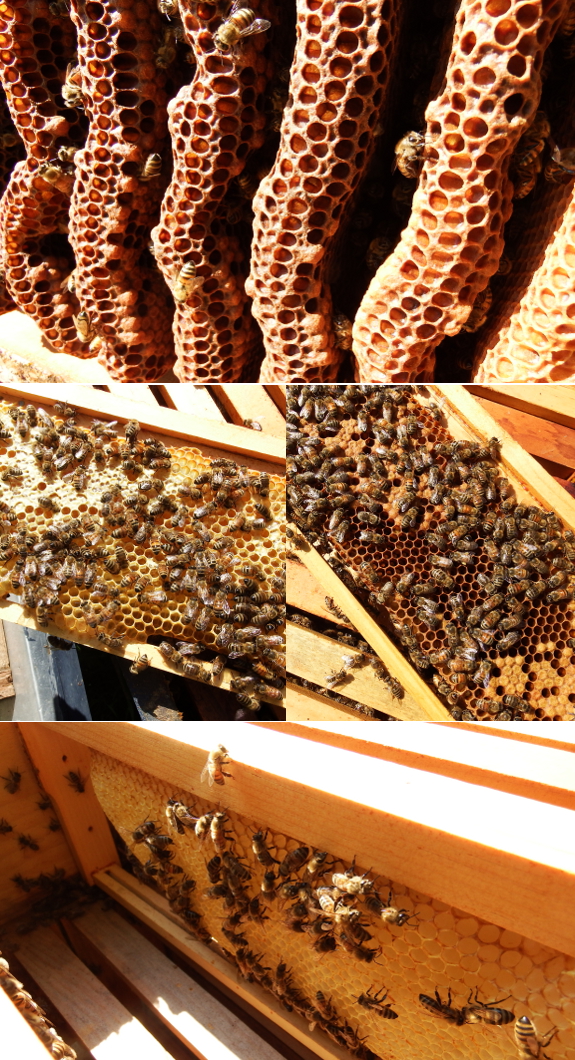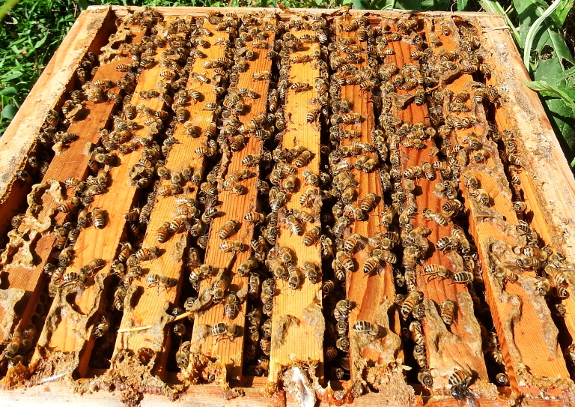
Checking on honey stores in early September

It's always handy when
delving into a bee hive to spend a couple of minutes beforehand thinking
through your goals for the operation. This time around, my plan was
simple --- I wanted to check on the state of our two hives' honey stores
to determine how much sugar water (if any) they need to stock up for the winter.

The mother hive is shown
on the left in the first photo in this post, and you can see the
hardware is a weird Langstroth-Warre mixture. As long-term readers know,
I've been trying to convert this colony from Warre to Langstroth boxes all summer, but the queen seems to want to stay up in the Warre box. The top photo in this conglomeration shows that Warre attic --- still disappointingly full of brood.
The good news is that the queen has finally at least started to
lay in the Langstroth hive, suggesting I may be able to finish the
conversion eventually. The two photos in the middle show frames from the
top Langstroth super, some of which contain honey (mostly uncapped) and
some of which contain brood. Yes, there is
a lot less honey present than there was earlier in the summer --- we
always see that pattern with a spring nectar flow followed by a summer
dearth.
The third box from the
top is shown in the bottom photo. The bees are still working on drawing
out comb here, and they haven't even reached the Langstroth basement
(the fourth box from the top).
So, the in-use area of
this hive is primarily two boxes, much of which is brood. Yep, I need to
keep feeding despite the fall nectar flow, and I should probably
increase their ration from once a week to every time they empty the jar.

I didn't take as many
photos of the daughter hive since it's much harder to pull out Warre
frames and look inside. Like the mother hive, this colony has four
boxes, and here all of the comb is drawn. But the daughter's attic is
pretty much empty and so is the basement, so the bees are primarily
working in the middle two boxes (just like in the mother hive). Based on
weight, I'd say this colony might survive without feeding, but if I can
track down my second feeder lid I'll probably put these girls back on
the dole too.
I'm always disappointed when I have to feed honeybees, but it's not a
surprise after a split and a swarm in the same year. On the other hand,
it's reassuring to see such large numbers of workers in both hives,
suggesting that if the weather doesn't cool too quickly they may do well
on all of the fall flowers that are currently in bloom. So I'll provide
sugar water and they'll stock up on wild nectar and pollen, and we'll
both dream about honey next year.
Want more in-depth information? Browse through our books.
Or explore more posts by date or by subject.
About us: Anna Hess and Mark Hamilton spent over a decade living self-sufficiently in the mountains of Virginia before moving north to start over from scratch in the foothills of Ohio. They've experimented with permaculture, no-till gardening, trailersteading, home-based microbusinesses and much more, writing about their adventures in both blogs and books.
Want to be notified when new comments are posted on this page? Click on the RSS button after you add a comment to subscribe to the comment feed, or simply check the box beside "email replies to me" while writing your comment.

Sheryl Lee --- I'm not really the person to ask because our climate is so markedly different from yours. I'd say that in northern California, your bees might even be able to come out and dine on warm days in the winter. Perhaps you have ornamentals that flower then? In contrast, our bees are stuck inside for at least four months in the winter with no chance of external feeding. So rather than getting numbers from me, I recommend hunting down local beekeepers to give you their ideas.
Either way, though, if you're going to need to feed, it's better to do so in the fall rather than the winter. When the weather is chilly, bees won't accept sugar water, and they certainly can't condense it down into honey. Plus, feeding will prompt them to expand their colony, when you really want them to slim down for the winter. So now's the time to be thinking of winter stores!